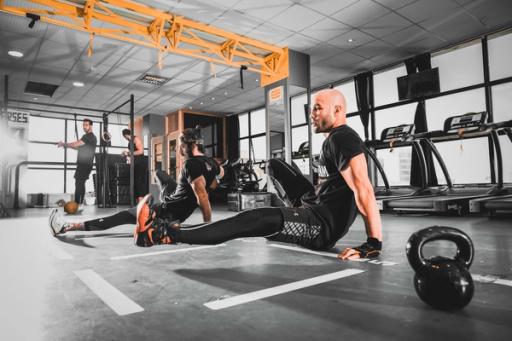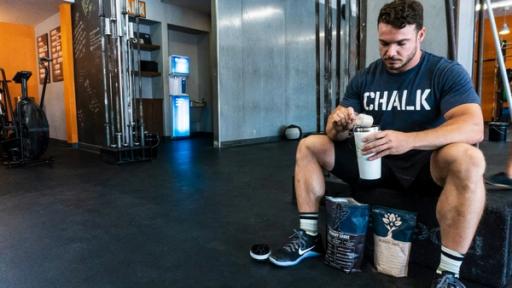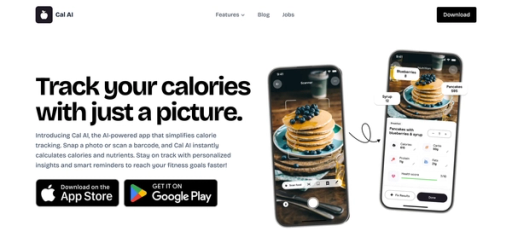
When it comes to tracking calories burned, there’s a lot of guesswork involved. For example, if you search online for how many calories you burned doing a particular activity, you’ll find all sorts of estimates that could help you. But these numbers often vary greatly. Why? Because they take into account variables like your age, weight, and sex and rely on averages that don’t apply to you. Wouldn’t cutting through all the noise and pinpointing the number of calories you burned on that last jog be nice? The most accurate way to measure burned calories can help you do that. In this article, we’ll explore the best methods for tracking calories burned to help you confidently track this critical fitness metric and eliminate the guesswork to make smarter decisions to reach your fitness goals faster. Calorie tracking just got a lot easier. So, how calories are measured?
Cal AI's calorie tracker offers a personalized approach to measuring calories burned, eliminating guesswork and allowing you to make informed decisions to reach your goals.

Calorie burn refers to the number of calories your body uses to keep you alive and functioning throughout the day. Your calorie burn is the sum of three components:
Let’s take a closer look at each of these components.
The number of calories needed to maintain the essential functions of life is referred to as the “Basal Metabolic Rate,” or “BMR.” These essential functions or tasks are:
Your BMR depends in large part on your age and size.
While you can increase your BMR by increasing your lean muscle mass, this value is generally consistent from month to month.
There is no such thing as a free lunch. If you want to digest your food, you must spend some calories to break it down into usable components. This physiological phenomenon is sometimes called the “Thermic Effect of Food” and collectively refers to the calories used to:
Some foods require more calories to process than others. For example, high-fiber brown rice has a higher thermic effect than its low-fiber counterpart, white rice. About 10% of our total caloric intake is used to process food, but this varies significantly by diet, especially by the percentage of protein in the diet. One study showed that 20-35% of the calories consumed as protein are used up digesting that protein.
Any level of activity beyond the basics of staying alive increases the rate of caloric consumption above the BMR. The more you do, the more calories it takes to power that work.
You have the most control over these calories, so our caloric needs vary so much daily. You can’t meaningfully change your BMR in a week, but adding a 30-minute jog will increase your daily caloric consumption by anywhere from 250 to 550 calories.
Over 100 years ago, Arthur Harris and Francis Benedict came up with the “Harris-Benedict Equation” for predicting BMR from:
While minor changes to these formulas have been made in the century since they still largely remain intact, their staying power should not be interpreted to be a sign of accuracy—the “Revised Harris-Benedict Equations,” which were developed in 1984 and are considered the most accurate BMR prediction using only height, weight, age, and biological sex, is still known to have only a 95% confidence level of ±213 kcal/day for men and ±201 kcal/day for women.
Using incorrect biometric data, like an out-of-date weight, can further increase the error between your BMR estimate and the truth. So, to maximize accuracy, it’s essential to ensure data like your height and weight are up to date in your app. One common confusion is the difference between BMR and RMR (resting metabolic rate).
As mentioned above, BMR is the calories associated with maintaining the necessary functions of sustaining life (things like breathing). At the same time, RMR is used as an estimate of “ordinary” non-workout caloric consumption and, therefore, includes all forms of “ordinary activity” (things like cooking breakfast).
If you have ever used an online calculator that predicted your daily caloric needs and incorporated information like “How Active Are You?” then that was an RMR calculator, not a BMR calculator. The practical difference is slight, but in the WHOOP world, we use BMR and then account for things like the different caloric needs of someone with a desk job versus an Emergency Room nurse on their feet all day in our “Active Burn” calculation. Notice that the HB method does not take into account your body composition. Individuals with more muscle tend to be more metabolically active and burn more calories. The HB method overestimates calorie burn for individuals with a high body fat percentage and underestimates calorie burn for those with low body fat (and thus more muscle). While it’s imperfect, the HB method is a helpful starting point.
BMR Men = 66 + (6.23 x weight in pounds) + (12.7 x height in inches) – (6.8 x age) BMR Women = 655 + (4.35 x weight in pounds) + (4.7 x height in inches) – (4.7 x age)
The Katch and McArdle (KA) method considers your body composition to arrive at your BMR and is, therefore, believed to be more accurate. The KA method uses the same activity multiplier as the HB method but has a significant downside.
The KA calculation depends on your body fat measurement, which may not be accurate (depending on what type of body fat measurement you use). I would take the KA method over the HB method, but they usually only vary by a few hundred calories on the high end for the average person.
BMR (Men + Women) = 370 + (21.6 x lean body mass in kg) Lean Body Mass = weight in kg – (weight in kg x body fat %) 1 kg = 2.2 pounds, so divide your weight by 2.2 to get your weight in kg
A more precise way to measure your BMR is with a metabolic analyzer. If you fear you have a very slow metabolism, this may be a smart idea for you. It works by breathing into a tube for around 10 minutes, and the analyzer gives you a reading.
Because a Metabolic Analyzer can cost thousands of dollars, finding a nutrition practice or hospital that charges for the test per reading (usually around $150) is best. Even the metabolic analyzer has drawbacks because your BMR can fluctuate depending on several factors. Still, it’s considered the gold standard of BMR measurement.
The best way to measure your activity level is by using a calorie tracker like Fitbit, which attempts to measure your movement with accelerometers. None of these trackers is scientifically proven to calculate calorie burn accurately, and they range in price from $99 to $299.
A couple of challenges these trackers face are measuring your calorie burn when cycling or weightlifting. These calorie trackers are interesting and have the potential to be a motivational tool to help people get off the couch.
So, how do you accurately figure out your calorie burn if your BMR is a moving target that’s tough to assess and your activity level is just as challenging?
Starting with the HB/KA methods will give most people an excellent idea of calorie burn, but ultimately, you need to validate them with measurable results (e.g., weight loss or weight gain).
Estimating the caloric expenditure of activity is a far trickier business than estimating BMR, and even less relevant third-party research has been done in this area. The most accurate way to calculate calories burnt during exercise is through indirect calorimetry, which measures gas exchange (oxygen and carbon dioxide).
Since indirect calorimetry requires using a device covering the nose and mouth, such a technology is not available in wrist-worn devices. Working within the limitations of a wrist-worn device, calorie estimates using HR have been shown to outperform far those using acceleration (motion) alone.
The most commonly used heart-rate-based formula for estimating caloric consumption during activity, or so-called “active calories,” was developed in South Africa in 2005. Despite being the best-performing published algorithm, it has two primary issues. First, it was fit only to exercise conducted at an intensity of 57%, 77%, and 90% of Max HR and therefore untested above and below these intensities. It was found to explain only 73.4% of the variance in actual energy expenditure.
A workout estimated to consume 1000 calories could have quickly burned 734 to 1266 calories—a massive difference if you use this information to modify your body composition. A 2017 study confirmed this difficulty when it demonstrated that none of the commercially available wearables on the market at the time of the analysis could estimate workout calories within what the Stanford researchers had determined to be an acceptable error.
Our active burn formula is inspired by the South African team’s methodologies and enhanced through our collection of millions of workouts’ worth of data across various activities and intensities. In a recent update, we modified our algorithm to model the dynamics of the lowest-intensity exercises better and integrate the active burn and BMR formulas by smoothing the transition between rest and exercise modes.
This update primarily impacts periods in which your heart rate is between 30% and 40% of your heart rate reserve - the range from your resting heart rate (0%) to your max HR (100%), which is above resting/restful activities but below the level at which people typically exercise. This update does not impact heart rates below 30% of my heart rate reserve and minimal implications for high-intensity exercise.
You probably already know that if you consume more calories than you expend, you will gain mass (either muscle or fat). If you consume fewer calories than you expend, you will lose mass, and if you match input to output, your weight will stay the same. Because of this seemingly simple relationship, many athletes are interested in tracking their daily caloric expenditure to manage their weight according to their goals.
You might not know how imprecise commercially available caloric intake and expenditure estimates are. The US Food and Drug Administration (FDA) requires food labels to be within 20% accurate. Still, studies have shown that food labels are more likely to underestimate caloric content than overestimate it.
Calorie estimates on menus were shown to be among the worst culprits of caloric inaccuracy, as changes in ingredient availability and cooking style lead to inconsistent preparation of even everyday dishes.
The FDA’s seemingly loose 20% error bounds are also necessary as whole foods have natural variation in their caloric density—everything from weather, soil quality, plant health, and ripeness contributes to how nutrient— and calorically dense produce is.
Therefore, not surprisingly, natural foods—like salad—tend to differ from their advertised caloric contents by more than processed foods—like candy bars—which tend to be more accurate in their nutrition labels.
This means that even if you weigh every gram of food you put in your body, you couldn’t possibly count your caloric intake with more petite than a 20% error bound. Those 2000 calories you believe I consumed could easily have been 2400, an error bar approximately the size of a McDonald’s Double Cheeseburger.
Regardless of what any calorie tracker is advertising, estimates of caloric consumption need to be understood as estimates. But that doesn’t mean they aren’t helpful. Heart-rate-based calorie estimates scale reliably with accurate caloric consumption, meaning that you can look at trends in caloric burn and trust that it’s accurately identifying relatively high and low calorie-burn periods.
This reliability is key to its use because eating more or less on days when you burn more or fewer calories is still a reasonable way to action this data.
On the ingestion side, it is essential to understand all the limitations on accurate calorie counting, even with the most diligent and intentional tracking practices:
A 2013 issue of Scientific American provides a more exhaustive review of all challenges with accurately counting calories. For all these reasons, WHOOP always recommends mindful eating—paying attention to portion sizes and checking in with yourself if you feel full.

Tracking calories can help you reach your goals, but obsessing over every calorie count isn’t necessary for everyone. Focus on balance and sustainability, not rigid tracking. If you find that tracking helps you, by all means, track your way to your goals. Just remember that it’s okay to take breaks and be flexible.
There are no food-tracking police (thank God), so you don’t have to do anything. But if you’re trying to estimate how many calories I eat daily roughly, I should log everything as much as possible. If I snack on a cookie, I put a cookie into my app.
I’ll sometimes skip an entire day of tracking, but I won’t log a partial day. If I eat 1,200 calories before dinner and then go to a party and eat 15 different little things that are impossible to track accurately, I might say, “fuck it,” and delete the whole day.
But I wouldn’t leave it at 1,200 because, looking back, it will seem like that entire day was only 1,200 calories. If I know I ate more than usual and I want to ensure my tracking shows it, I’ll pick a placeholder like a restaurant meal (my app has an entry for "Thanksgiving") and log whatever gets me, say, 3,000 calories of that.
Along the same lines, it’s tempting not to log things you think you “shouldn’t” be eating, but this backfires. In reality, if I’m eating 2,500 calories and only logging 2,000, I would look at my app and think, wow, I’m eating 2,000 calories and not losing weight. I would start to feel like I needed to eat even less than 2,000, and I might fall into one of those vicious cycles of restricting myself to smaller meals and then finding myself eating more untracked “cheat” meals.
This is not a healthy eating method and tends to worsen over time. Instead, I log everything. If I knew I was eating 2,500 calories and not losing weight, I would appreciate that my body could put 2,500 calories to good use daily. I would then eat slightly less—maybe 2,200—and see if that might be a more effective and sustainable approach.
Or, if you log everything, you can be honest with yourself and kinder to yourself. You just have to look at the numbers as neutral data, not as a judgment on whether you’re being “good.”

Cal AI transforms calorie tracking with cutting-edge AI technology. Just snap a photo of your meal, and we'll do the rest.
Our app combines your phone's depth sensor with advanced AI models to:
With 90% accuracy on visible foods and multiple tracking options like:
We've made nutrition tracking effortless. Whether you're scanning a full meal or a quick snack, Cal AI
Our AI learns from your feedback to improve accuracy. It includes personalized insights and smart reminders to keep you on track. Cal AI makes achieving your fitness goals simpler than ever. Track your calories with your camera using Cal AI's calorie tracker today!